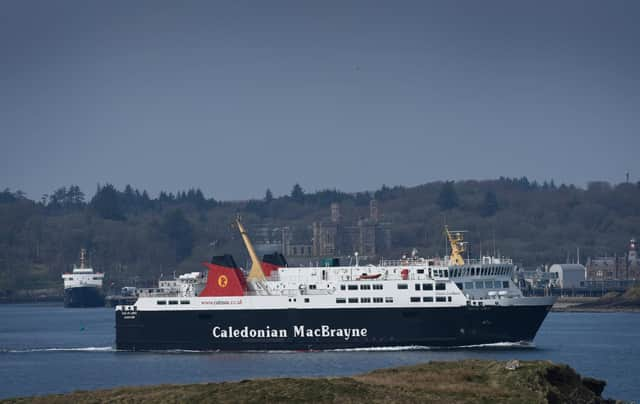Consultants' ferry report offers few options


A consultation announced in February 2017 led to the appointment of Ernst & Young in 2020 to provide a full report. This was delivered seven months ago but has only now been published by the Scottish Government.
While the report draws heavily on international comparators, much of its content was rendered irrelevant when Transport Minister, Jenny Gilruth, told MSPs last Thursday: “The First Minister has been absolutely clear that we will not consider unbundling or privatisation”.
Advertisement
Hide AdAdvertisement
Hide AdAll but one of the models looked at by Ernst & Young contain an element of one or both. In Norway, for example, most ferry services are privately operated and the licensing is devolved to local levels. Placing a blanket ban on either will strictly limit future options.
While privatisation may be politically unacceptable, the advance rejection of “unbundling” pre-empts decentralisation options. For example, the Gourock headquartering of Caledonian MacBrayne is not even referred to in the report as a matter for discussion.
The report points strongly toward re-uniting procurement and operations as represented by CMAL and CalMac. However, Ms Gilruth told MSPs: “I give them the absolute assurance that there will be no takeover imposed on any one organisation”.
Within these limited parameters, Ms Gilruth promised to “directly consult island communities on next steps” and intimated that the former leader of Comhairle nan Eilean Siar, Angus Campbell, who chairs the Ferries Community Board, will lead this work.
Advertisement
Hide AdAdvertisement
Hide AdRather oddly, Ms Gilruth continued: “We also need to ensure that such organisations are representative of the communities that they serve. To that end, I am delighted to confirm that Morag McNeill will take up position formally as the chair of Caledonian Maritime Assets Ltd”.
Ms McNeill is an Edinburgh-based lawyer who has been acting CMAL chair since Copenhagen-based Erik Østergaard was transferred to the same role at CalMac, having led CMAL throughout the Ferguson debacle. The Gazette understands the appointment of one islander to the CMAL board is imminent.
The Minister undertook that “for every period of prolonged disruption, I will convene a resilience group with the ferries community board, CalMac and local partners” but otherwise there was little in her statement to bring short-term comfort.
She then complained about politicians who “encourage headline-grabbing media stories about our ferries being broken, which gives the completely wrong impression that our islands are closed and, in some instances, unreachable … Surely, we should all be seeking more light and less heat”.
Advertisement
Hide AdAdvertisement
Hide AdLabour spokesman Neil Bibby said: “Although we need to look at the governance structures, the Scottish Government cannot distract us from the fact that islanders have an unreliable ferry service, mainly because we have an unreliable ferry fleet. Therefore, it is disappointing, but not surprising, that the statement on the future of Scottish ferries does not give islanders one single more Scottish ferry. When will capacity be increased, by how much and on which routes?”.
Tory MSP, Jamie Greene, added: “What we do not have is a firm commitment to procure and build new ferries. Given that we know how long it takes to design, procure, build and manufacture, and fund ferries properly, if we are to replace the current fleet of ferries, we need to start building them now.
“When will we actually see a firm plan, so that islanders can have some faith that the Government will be replacing those ferries and that history will not repeat itself in five or ten years?”.
In response, Ms Gilruth confirmed that negotiations are continuing to lease a vessel – presumably the ‘Pentalina’ and/or ‘Arrow’ – an option until recently rejected by the Scottish Government. She said: “I recognise that, as we go into winter, there is a level of anxiety in our island communities, and I want to give them a reassurance. The best way that we can do that is to bring in an additional vessel”.
Advertisement
Hide AdAdvertisement
Hide AdMuch of the Ernst & Young report is devoted to an “international benchmarking exercise” which looks at Canada, Norway, Australia and New Zealand.
In Norway, most of more than 200 contracts are granted by local authorities to private companies who both own and operate the vessels. British Columbia is the only other jurisdiction in which ferries are publicly owned and operated, although this is on a 60 year contract – compared to eight for CalMac.
Another feature of British Columbia is that there is a Commissioner, or regulator, to ensure that contractual terms are delivered. The Ernst & Young report takes a “positive’ view of this option: “An independent commissioner or regulator has the potential to drive enhanced passenger experience and accountability”.
The merger of CMAL and CalMac, which seems likely to be the option favoured by the Scottish Government, would be “complex”, says the report, “with legal, tax, pension and HR implications”.
Advertisement
Hide AdAdvertisement
Hide AdHowever, it offers “potential for an improved passenger experience in the longer term once initial challenges of integration are overcome. The new body may also benefit from greater alignment of objectives and be more easily understood by users”.
The current CalMac contract is due to expire in under two years.